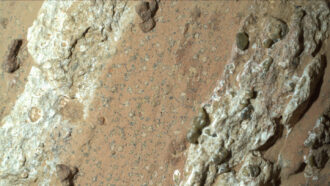Space
-
 Space
SpaceLet’s learn about supernovas
Supernovas are spectacular stellar explosions that sprinkle heavy elements throughout the universe.
-
 Space
SpaceMicroscopic black holes may be flying through our solar system
These flybys could jostle the orbits of planets and satellites as teeny black holes whiz by us once a decade or so.
-
 Space
SpaceThe moon has new tales to share, some from its secretive far side
Ongoing observations and new lunar rock samples, including the first from its far side, should point to how both the moon and our Earth evolved.
By Liz Kruesi -
 Planets
PlanetsScientists Say: Theia
Clues about this ancient protoplanet's catastrophic end may have been entombed in Earth's lower mantle for billions of years.
-
 Space
SpaceWhy are scientists suddenly interested in UFOs?
For decades, science mostly ignored UFOs. Then in 2015 Navy pilots started reporting them. The U.S. government enlisted scientists to investigate.
-
 Animals
AnimalsWerewolves could learn from other critters when to hunt
Werewolves aren’t the only creatures that undergo transformation under the full moon. But could weak werewolves be at risk of becoming prey?
-
 Planets
PlanetsExperiment: Make your own craters!
Let’s make our own craters in cocoa and flour to learn how these features form throughout the solar system — and why they’re different sizes.
-
 Space
SpaceSpacecraft need an extra boost to travel between stars
Star Wars makes space travel look easy by breaking the laws of physics. Off-screen, the technology for spacecraft to reach other worlds doesn’t exist yet.
-
 Space
SpaceScientists Say: Campfire
These miniature solar flares could help solve a big mystery about our sun.
-
 Planets
PlanetsAnalyze This: Jupiter’s Great Red Spot is shrinking
If the windstorm keeps dwindling, the Great Red Spot could someday disappear — like an earlier spot observed in the 1600s.
-
 Space
SpaceScientists Say: Kugelblitz
A black hole made of pure light —or kugelblitz — may be possible, at least in theory. But in practice: impossible.
-
 Planets
Planets‘Percy,’ NASA’s rover, finds its first hint of ancient life on Mars
The robot examined a Mars rock containing organic compounds and “leopard spots.” On Earth, such spots usually come from microbial life.